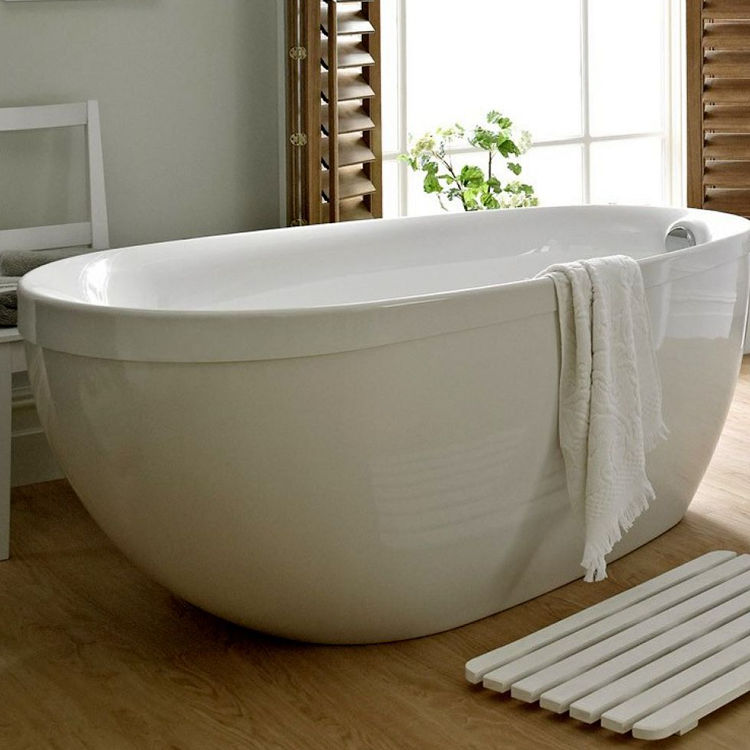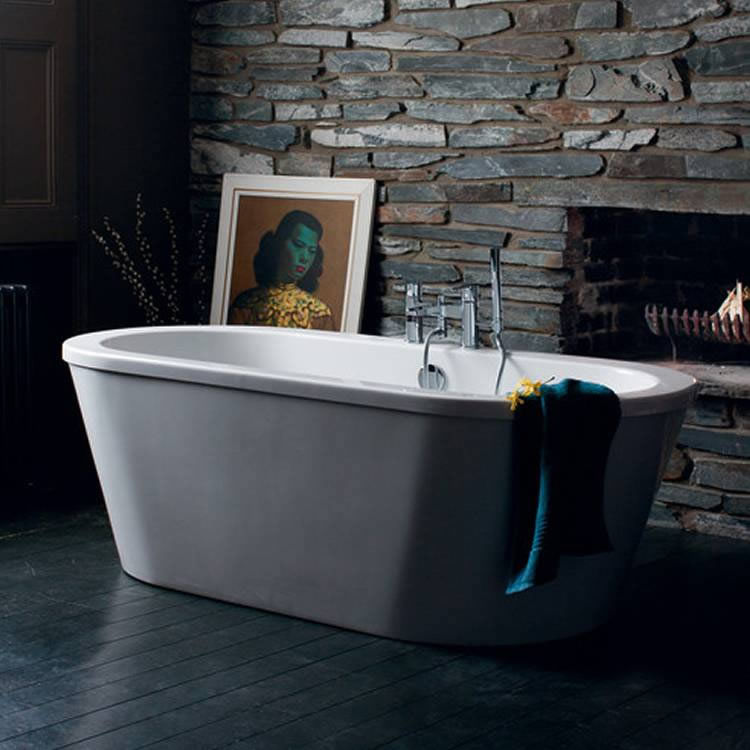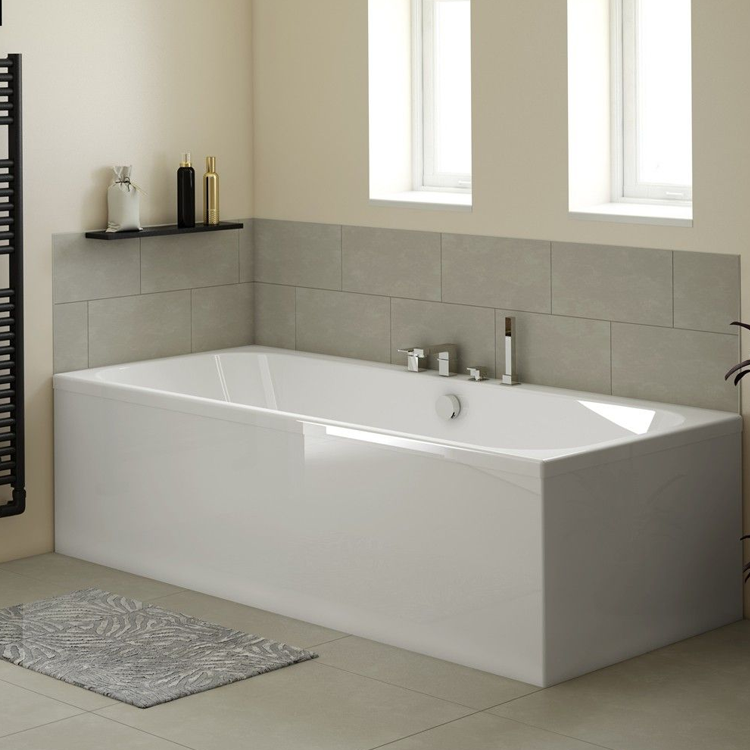Acrylic Baths: Are they any good and what types can you get?

Acrylic baths are a common fixture of both modern and traditional bathrooms. It’s likely that every bath you’ve used up until now has been an acrylic bath and you’ve just taken it for granted. But there are several different acrylic baths that are designed to be more durable, warmer, and comfortable, despite them being sourced from the same material.
Keep reading below to discover how manufacturers have made this popular material their own and discover the subtle differences in how it’s used.

What is Acrylic?
A transparent plastic material known for its strength, stiffness and glass-like qualities, acrylic is easily fabricated and lightweight.
Widely used for a range of products, it’s popular for bathroom use as the material can be bonded with adhesives and solvents and is often reinforced with fibreglass for increased durability. It’s also a non-porous material, making it easy to clean as well as affordable, perfect for bathroom companies to mass produce and keep the quality.
What are the types of acrylics?
There are two different types of acrylics – Extruded and cell cast.
Both are used in the manufacture of baths, but many popular acrylic terms – Plexiglas, for example – are brand names, rather than separate materials. There are many acrylic brands that manufacture the material for a range of uses, especially when it comes to bathroom products – but they all start with either Extruded or cell cast acrylic.
Extruded acrylic is also known as “continuous cast” and creates a large, thin sheet that can then be cut to size. But, because it’s a thin sheet, it’s more prone to cracks and faults.
Cell cast acrylic is poured into a glass mould, creating a stronger material that features good UV resistance and low water absorption, ideal for use in bathrooms, whether it be a bath, shower tray or enclosure.
What is an acrylic bath?
A common material used for the manufacture of baths, acrylic baths are quite strong even without added reinforcement. Even budget acrylic baths usually feature a stronger, wooden baseboards and fibreglass reinforcement, ensuring they’ll last a lifetime without breaking the bank.
They’re also able to be moulded into a range of shapes of sizes and that means it’s easier to find one that will suit your space, without asking for a bespoke design or re-arranging your entire bathroom around it.
Are acrylic baths any good and how strong are they?
Acrylic baths are also warmer to the touch than a steel bath, for example, meaning the water stays warmer for longer and there’s less chance of a shock when you enter the tub. A non-porous material, acrylic baths are also easy to clean and any accidental scratches or scuffs can be buffed out with little effort.
This versatility means that manufacturers have found ways to improve these already impressive properties, while also creating designs and features that can lend a unique look to your bathroom, without breaking the bank on a cast iron or steel bath.
Carronite

What is Carronite, what is it made of and what are Carronite Baths?
Considered the gold standard of acrylic bath manufacturers, Carron Baths are made in Britain and they pride themselves on pushing the boundaries when it comes to bathing.
Hand finished with a 30 year guarantee, Carronite baths feature a unique, patented triple layer reinforcement system that uses extra layers of acrylic to create a bath that’s twice as thick at 10mm, rather than 4 or 5mm.
That thickness is apparent in the unique layers that make up a Carronite bath. There’s a reinforced layer on the top, a 5mm thick acrylic layer in the middle and an 18mm baseboard, custom built for the bath to create further stability and security.
Carronite vs Acrylic
Stronger and heavier than your typical bath, it’s reported that four Carronite baths can take up to 7.5 tonnes of force with ease. Fair to say, you can be sure of a long lasting fixture that offers peace of mind.
But the rigid manufacture of a Carronite bath doesn’t mean you’re limited to certain designs or looks for your space. Almost every Carron bath can be upgraded to Carronite and some can fit a separate bath screen if you’re looking for specific shower bath for your bathroom.
Is Carronite worth it for baths?
While they are typically more expensive than a standard acrylic bath, Carronite baths are designed to last a lifetime and it really comes down to personal preference. They’re warmer, more durable and will potentially outlive you if you take care of them – making them a safe choice if you’re not working to a tight budget.
Lucite

What is Lucite acrylic?
Developed by DuPont in the 1930’s, Lucite acrylic is a chemically derived variant of standard acrylic. A brand name, rather than a separate material.
Being so popular has made it synonymous with acrylic goods – more than just baths, for example – much like Kleenex is to tissues and Sellotape is to sticky tape.
Used for all kinds of applications over the years, from vintage jewellery to chic furniture, it’s become increasingly popular around the bathroom, thanks to its waterproof properties and warm touch, creating a more luxurious, versatile fixture that will stand the test of time.
Cleargreen Baths
Made using 30% recycled material and designed to withstand up to 2.3 tonnes, Cleargreen baths from Britton are set apart from normal acrylic baths with their steel reinforced system that makes them some of the most durable Lucite acrylic baths available.
Their unique process features 8mm steel reinforcement rods within the rim of the bath, as well as a fibreglass baseboard and a Lucite acrylic layer. Again, this unique design doesn’t stifle their ranges and you can still get single, double ended or shower baths to suit any bathroom scheme.
Compared to Carronite, all Cleargreen baths are reinforced as standard and they’re able to retain heat for up to 30 minutes longer than a normal acrylic bath, with a galvanised steel leg frame included for increased rigidity.
A eco-friendlier choice for your bathroom, Cleargreen baths also use a recycled fibreglass baseboard that makes them ideal if you’re more environmentally conscious. A fibreglass baseboard also makes the bath more comfortable and flexible, as well as lightweight.
These unique properties go across their entire range, from the freestanding baths, ideal if you’re looking for a centrepiece for your bathroom, or the more versatile standard or shower baths that feature a rectangular look, and that will suit any contemporary space.

Tissino
Tissino baths, like Cleargreen, are manufactured with 5mm thick, reinforced Lucite acrylic. This makes them lighter than other standard bath materials, especially when compared to steel or cast-iron baths, with the acrylic itself being versatile enough to suit a range of spaces.
What sets Tissino apart is the extra layer of resin used during manufacture on their Premium range of baths, making the bath stronger and longer lasting, while dramatically improving the heat retaining properties. Some of their ranges – such as this Angelo D shaped bath – are manufactured with twin-skinned acrylic, which also features extra space for an integrated waste and overflow between the reinforced fibreglass layers.
This means their Premium Lucite acrylic bath range retains all the properties of a standard acrylic bath, while being as a strong as a cast iron bath. Of course, this makes them heavier than their normal range, but once sealed and properly installed, they’re virtually indestructible, offering further peace of mind – especially important for a busy family bathroom that sees daily use.
Both their normal and Premium baths also feature a unique, mould-resistant Perma Bianco finish that promises to prevent discolouration over time, and they’re also designed with comfort in mind, featuring no tap holes to offer plenty of options and space for you to truly relax.
Lucite vs Acrylic
Slightly heavier, denser and more durable than standard acrylic, Lucite is more resistant to household cleaning products and has antibacterial properties that are especially useful in a bathroom space.
Does Lucite scratch?
While Lucite is a stronger material than a standard acrylic bath and harder to shatter than glass, it is slightly more susceptible to scratches and they do require more effort to buff out. It’s nothing more than some elbow grease and a bespoke Lucite polishing kit that will keep your bath sparkling, but deeper scratches might require the attention of a professional to polish it out.
Which type of acrylic bath to choose and how do they compare in terms of cost?
As you can see, there’s a wide range of acrylic baths available for all budgets, whether you’re looking for a quick upgrade or a bath that will stand the test of time.
Of course, it all depends on what you’re after from your bath – are you after a more luxurious soak that will stay warmer for longer? Try a Lucite bath. Are you looking for a bath that will withstand years of school runs and bedtimes? Go for Carronite. Trying not to go overboard on a rarely used guest bathroom? Try Britton's range of baths.
Browse our full range of Acrylic Baths from top brands today and get in touch with us at Sanctuary Bathrooms for more friendly advice if you can’t find the perfect fit for your space.